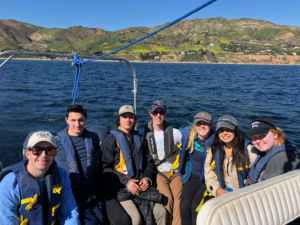Hi everyone! Our team is part of the IOES senior practicum project at UCLA. We are a group of undergraduates researching ocean acidification in the Santa Monica Bay. The practicum is designed to challenge us with real world problems that could yield sustainable solutions.
For this project, we’ve partnered with The Bay Foundation to monitor sea grass beds in the Santa Monica Bay along Lechuza, El Matador, and Amarillo beaches. The Bay Foundation’s mission is to restore and enhance Santa Monica Bay. Previously focusing restoration on kelp forests, they’re aiming to start a seagrass restoration effort in 2020. Seagrass has the potential to mitigate ocean acidification by drawing carbon dioxide from the water, making conditions less acidic and more favorable for marine organisms.
To study seagrass beds, we’ve directed our efforts towards monitoring pH at the sites mentioned above on various boat trips on the Bay Foundation’s vessel and the UCLA research vessel, the zodiac.
We’ve visited these sites and conducted readings with a pH probe and a GoPro to determine visual density of seagrass beds at different depths. One of the sites, our control (Dockweiler beach) is being used as a potential donor site. The Bay Foundation wishes to find suitable donor/transplant sites for seagrass beds for restoration purposes. We also took water samples to conduct an eDNA, nutrient, and carbonate chemistry analysis.
You can also follow us on Facebook at:
https://www.facebook.com/
Meet our team below!

From left to right: Ryan, Gonzalo, Eyal, Evan, Mackenzie, Britanie, and Emma

